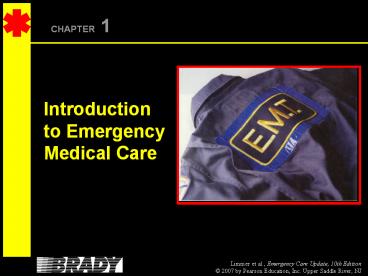Introduction to Emergency Medical Care PowerPoint PPT Presentation
1 / 30
Title: Introduction to Emergency Medical Care
1
CHAPTER 1
Introduction to Emergency Medical Care
2
Overview of the EMS System
3
NHTSA Standards for EMS Systems
- Regulation and Policy
- Resource Management
- Human Resources and Training
- Transportation
- Facilities
- Communications
- Public Information and Education
- Medical Direction
- Trauma Systems
- Evaluation
4
Components of theEmergency Medical System
- Prehospital Care
- Emergency Departments
Continued
5
Components of theEmergency Medical System
- Specialty Facilities
- Trauma centers
- Burn centers
- Pediatric centers
- Poison control centers
- Other specialty centers
6
Accessing the EMS System
- 9-1-1
- Communities without 9-1-1
7
Emergency Department Hospital Personnel
- Physicians
- Nurses
- Other Health Professionals
8
Liaison with OtherPublic Safety Workers
- Local Law Enforcement
- State and Federal Law Enforcement
9
The chain of human resources that make up the EMS
system
10
Levels of EMS Training
- First Responder
- EMTBasic
- EMTIntermediate
- EMTParamedic
11
Roles and Responsibilities of the EMTB
12
Roles and Responsibilities
- Personal safety
- Safety of crew, patient, and bystanders
- Patient assessment
- Patient care
- Lifting and moving patients safely
- Transport/transfer of care
- Record-keeping/ data collection
- Patient advocacy
13
Professional Attributes and Traits
14
Professional Attributesand Traits
- Appearance
- Keeps knowledge and skills up to date
- Puts patients needs as a priority without
endangering self
Continued
15
Professional Attributesand Traits
Maintains current knowledge of local, state, and
national issues affecting EMS
16
National Registry ofEmergency Medical Technicians
17
Quality Improvement
18
Quality Improvement
Continuous self-review to identify aspects of the
system that require improvement.
19
Quality Improvement
If a problem is identified, a plan is developed
and implemented to prevent further occurrences of
the same problem.
20
Role of the EMTB
- Careful documentation
- Become involved in the QI process
- Obtain feedback from hospital staff
Continued
21
Role of the EMTB (cont.)
- Maintain equipment
- Continuing education
- Skill maintenance
22
Medical Direction
23
Medical Direction
- A physician responsible for the clinical and
patient care aspects of an EMS system. - Every ambulance/rescue squad must have physician
medical direction.
24
Medical Direction
- Oversees training
- Develops protocols
- Develops standing orders
- Integral part of QI process
25
EMTB Relationship withMedical Direction
- Designated agent of the physician.
- Care rendered is considered an extension of the
medical directors authority (varies by state
law).
26
Types of Medical Direction
- On-line
- Off-line
- Telephone
- Radio
- Protocols
- Standing orders
27
Review Questions
1. What are the components of the EMS system? 2.
What are some of the special designations that
hospitals have? 3. What are the four national
levels of EMS training and certification?
28
Review Questions
4. What are the roles and responsibilities of
the EMTB? 5. Name the desirable personal and
physical attributes of an EMTB. 6. Define
quality improvement. 7. What is the difference
between on-line and off-line medical direction?
29
STREET SCENES
- What would have been a more appropriate action
for Chuck when the shift started? - What behavior characteristics of Chucks would be
considered unprofessional?
30
STREET SCENES
- What would you expect from someone providing
initial field training? - What did Susan Miller do that was appropriate and
professional?

